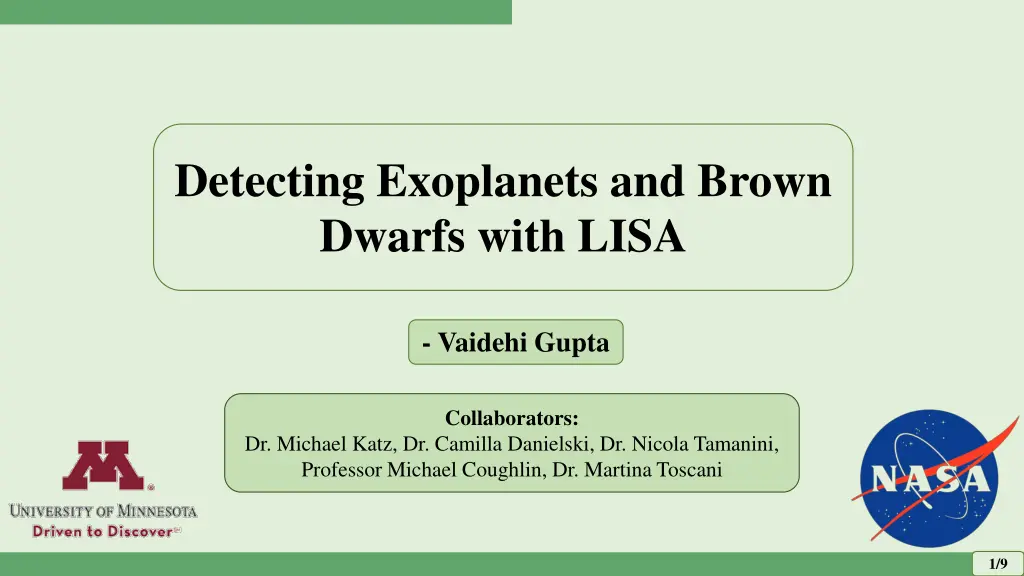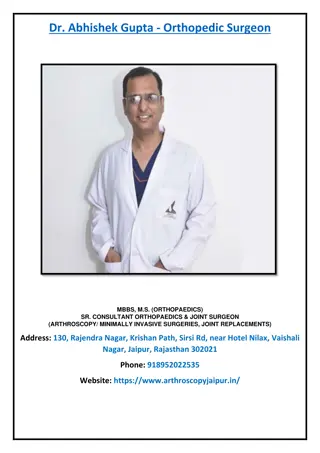
Detecting Exoplanets and Brown Dwarfs with LISA
Explore the detection of exoplanets and brown dwarfs orbiting Double White Dwarf binaries using the LISA mission. Collaborators include Dr. Michael Katz, Dr. Camilla Danielski, Dr. Nicola Tamanini, Professor Michael Coughlin, and Dr. Martina Toscani.
Download Presentation

Please find below an Image/Link to download the presentation.
The content on the website is provided AS IS for your information and personal use only. It may not be sold, licensed, or shared on other websites without obtaining consent from the author. If you encounter any issues during the download, it is possible that the publisher has removed the file from their server.
You are allowed to download the files provided on this website for personal or commercial use, subject to the condition that they are used lawfully. All files are the property of their respective owners.
The content on the website is provided AS IS for your information and personal use only. It may not be sold, licensed, or shared on other websites without obtaining consent from the author.
E N D
Presentation Transcript
Detecting Exoplanets and Brown Dwarfs with LISA - Vaidehi Gupta Collaborators: Dr. Michael Katz, Dr. Camilla Danielski, Dr. Nicola Tamanini, Professor Michael Coughlin, Dr. Martina Toscani 1/9
P-type sub-stellar objects that orbit a Double White Dwarf Binary What type of exoplanets and brown dwarfs are we talking about and Why? Abundance of DWDs emitting in the LISA band. Tamanini & Danielski 2019 White Dwarf Pollution supports the existence of a planet around a WD. What evidence, if any, do we have to believe we would detect something? Planets can survive more around post-AGB binary than a single WD. Kostov et al, 2016 Danielski et al, Dec 2019 Main Questions Addressed We simulate GW from: (1) DWD system (2) DWD + injected SSO How do we verify the detectability of these sources with LISA? We conduct statistical tests to verify the detectability of SSOs Katz et al, 2022 What are the implications of this work on other astrophysical sources? 2/9
Third Body Priors Upper and Lower Values of Realizations Min Max 8 scenarios based on semi-major axis and mass distributions. 3 realizations to mitigate bias and statistical fluctuations. Period (days) 0.00098 0.248 d (kpc) 0.324 27.1 WD1 Mass (? ) 0.156 1.379 Semi-major axis distribution: Uniform distribution - ??(0.1 200 ??) log10uniform distribution - log ??(0.1 200 ??) log-normal distribution - ? ? = ? ?ln ? ?/2?2/?2? Power-law distribution - ? .61(0.1 200??) WD1 Radius (? ) 0.00269 0.022 WD2 Mass (? ) 0.193 1.3773 WD2 Radius (? ) 0.00274 0.0205 M3 (?J) 0.00315 83.816 Mass distribution: Uniform distribution - ??(1? 0.08 ? ) Combination of power law - ? 1.31between1? 16?Jand uniform for 16?J 0.08? 3/9
Simulating Waveforms ?0 ? ? ?0 DWD Signal Simulation A i ? ? ? ? ?2 ? ?0 ?0 Third body Signal A Simulation Danielski et al, Dec 2019 i ?2 ?2 ? ? ?2 ? 4/9
First Step Likelihood calculation at the injection of the third body. To see if the two waves are different enough to be detected. ??? = 1 2< ? ?| ? ?> = ? ?(< ????>+< ????> ? < ??|??>) Second Step Allowing the DWD parameters to evolve. Using MCMC, the likelihood between the DWD and the injected third body waveform is maximized. Performed to filter out sources before a computationally extensive Evidence calculation. Third Step Calculating the bayes factor through evidence calculations. Katz et al, 2022 The Evidence is computed through thermodynamic integration. The Bayes factor is the ratio of the evidence for the two models. 2log?? > 5 surely detectable 0 < 2log?? < 5 marginal, and 2log?? < 0 non-detectable. 5/9
Preliminary Results Estimated detectable Exoplanets and Brown Dwarfs A1 A2 28 29 21 B1 348 340 360 B2 347 55 51 C1 769 727 760 C2 94 115 115 D1 419 404 397 D2 52 70 41 Realization 1 168 Realization 2 179 Realization 3 163 6/9
Future Prospects Coming Soon! Generating final results from evidence runs and publishing the analysis. Applying the pipeline for different astrophysical sources. Investigating how to adapt the analysis in the global fit. Analysing the posterior distributions for sources that make it through the evidence cut. Performing the analysis for multiple planets or brown dwarfs. 7/9
Questions? 8/9
Thank you for your time and attention! 9/9
Evidence for Existence of Planet Around DWD Multiple Post common envelope planets detected Planets survived one CE phase. Planets survive more around compact binaries than around single stars. Kostov et al, 2016 23-32% of P-type exoplanets survive and orbit DWDs. Columba et al, 2023 Planets can also form a second generation disc around DWDs. Ledda, Danielski & Turrini et al, 2023 Second generation exoplanets, i.e., those that form after first CE phase, formed around DWDs, tend to be more stable. Nigioni et al, submitted
Second Step Allowing the DWD parameters to evolve. Methodology: Using eryn, an advanced MCMC sampler, the likelihood between the DWD and the injected third body waveform is maximized. Often likelihood maximization returns a biased DWD waveform template, but with a higher likelihood than the injection parameters. Likelihood maximization is performed to filter out sources before a computationally extensive Evidence calculation.
Third Step Calculating the bayes factor through evidence calculations. Methodology: The Evidence is computed through thermodynamic integration after locating maximum likelihood values. The log of the evidence relative to the prior at ? = 1 is given by: 1? log log? 1 = log? 0 + 0 The Bayes factor is the ratio of the evidence for the two models. If: 2log?? > 5 surely detectable 0 < 2log?? < 5 marginal, and 2log?? < 0 non-detectable.






















